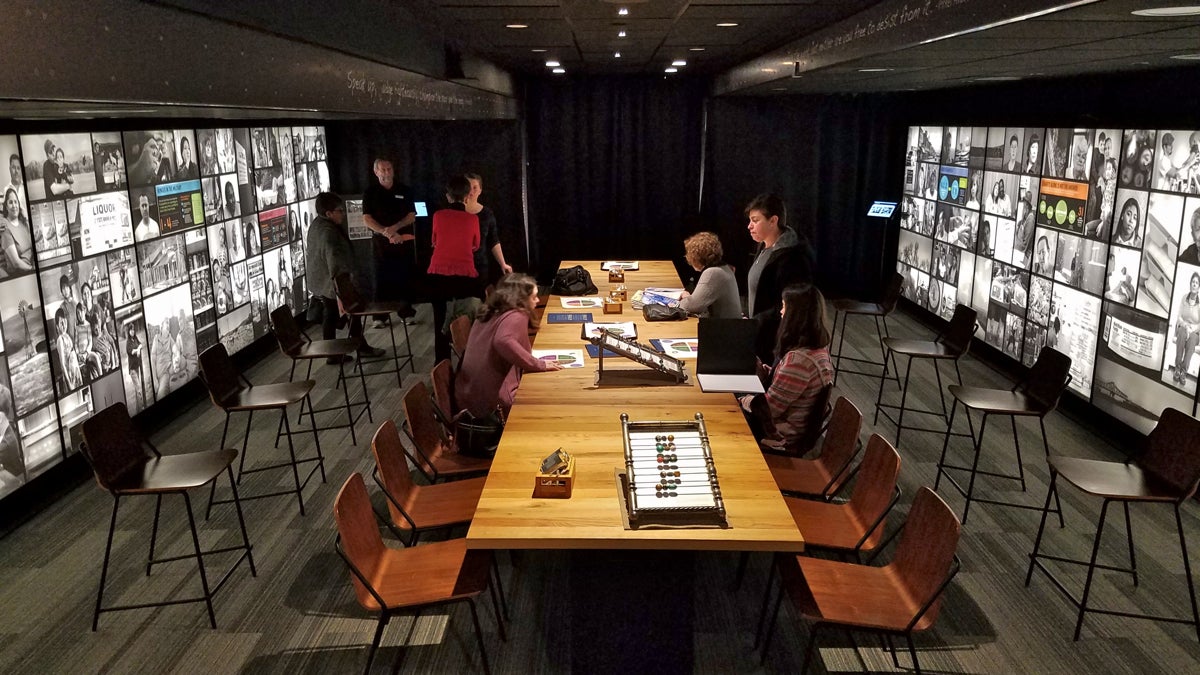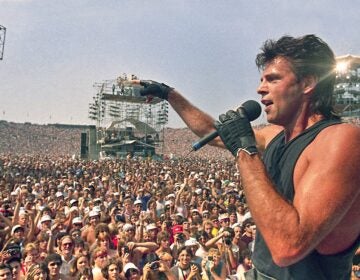‘Hunger doesn’t look the way you think it looks’

(Peter Crimmins/WHYY)
A mobile exhibition about the faces of hunger in America has rolled into the Philadelphia area.
The multimedia gallery of documentary photography and audio interviews is installed in a 53-foot semi-trailer that’s visiting Jewish synagogues across the country.
Once parked, the trailer folds out to almost 1,000 square feet of gallery space, much of it taken up by a long, wooden farm table with room for about 20 people.
“This Is Hunger” is like stepping into a documentary film: The darkened room comes to life with projected portraits, the subjects’ voices sound in different parts of the space, along with text and graphics projected onto the surface of the table.
After the 14-minute presentation, visitors are invited to explore more stories and statistics at their own pace.
“We wanted to put a face on the 44.2 million people who are hungry in America,” said tour facilitator Maya Joshua. “Hunger doesn’t look the way you think it looks.”
The exhibit was created by Mazon, a Jewish advocacy organization based in Los Angeles. It hired documentary photographer Barbara Grover to spend two years criss-crossing the country to document Americans who are food insecure — people like Bill from Detroit, who appears in the presentation.
“All my life, since I was 17 years old, I’ve served my country, been responsible, reliable, dependable, accountable, went to work every day and did what I was supposed to do,” said Bill, who struggles to feed his family.
“It makes me feel sometimes like a garbage can out there, waiting to be picked up and dumped,” he said.
The immersive presentation is a call to action — in the corners of the room are iPads loaded with online petitions to encourage members of Congress not to cut Supplemental Nutritional Assistance Program, known as SNAP or food stamps. Some U.S. lawmakers and President Trump have indicated they want to overhaul SNAP.
The people shown in the exhibit are not at death’s door — there are no images of emaciated arms and distended bellies that are often seen in photography from other parts of the world coping with severe famine and starvation. These images show people in urban and rural settings, who have places to live, clothes, some are even a little heavy.
Many are beset by health problems, forcing them to choose between paying for medicine and buying nutritious food. They often opt to eat cheap, low-quality food in order to get something in their stomachs.
“Food insecurity means they have some food, but the food they have access to is insufficient, or is not nutritious,” said Joshua. “We tend to not see hunger in our community. It tends to be invisible.”
Mazon chose to install this exhibition on a truck to bring it closer to its audience, hoping more people will see the show if it is almost literally in their backyards, Joshua said.
That’s why Mindy Cohen came to “This Is Hunger” while it was in the parking lot of the Keneseth Israel synagogue in Elkins Park. She is a congregant of the synagogue across the street — Beth Shalom — it is was easy to come with her two daughters.
“There are food deserts in the country and the city, and people can’t get fresh fruit — they can’t afford fresh vegetables,” she said in the parking lot after leaving the exhibit. “Food should not come out of a bag or a can. That’s what they were just showing — so many people just eat noodles because their all they can afford.”
The truck is on a 10-month tour of the United States, making 30 stops primarily at synagogues. It will be in the Philadelphia region for the next three weeks.
WHYY is your source for fact-based, in-depth journalism and information. As a nonprofit organization, we rely on financial support from readers like you. Please give today.





